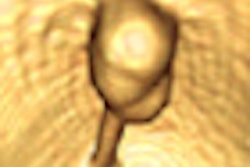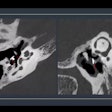A new study shows that virtual colonoscopy delivers a high positive predictive value (PPV) for the identification of patients with clinically significant polyps, reinforcing the results of earlier studies concluding that VC can predict the need for conventional colonoscopy and polypectomy with few false-positive detections.
Italian researchers found that VC (also known as CT colonography or CTC) identified nearly all of the patients who had lesions 6 mm or larger on optical colonoscopy. In addition, VC's false-positive rate was less than 1%, according to the study by Dr. Franco Iafrate, Dr. Cesare Hassan, Dr. Andrea Laghi, and colleagues from the University of Rome "La Sapienza" (European Journal of Radiology, February 14, 2011).
"When considering the relatively low prevalence of polyps expected in the study population -- most of the patients undergoing CTC for a screening purposes -- such a low rate of false-positive results is clearly related with a very high specificity of CTC in excluding meaningful lesions in those without polyps," the authors wrote.
Low PPV in a major trial
Not all virtual colonoscopy studies have generated high PPVs, and the discrepancy between studies with high and low PPVs is a key reason why the authors chose to study the statistic in a new cohort.
Specifically, the low PPV in the recent American College of Radiology Imaging Network (ACRIN) 6664 multicenter trial (New England Journal of Medicine, September 18, 2008, Vol. 359, pp. 1207-1217) still isn't fully understood, the authors noted.
"In the largest multicenter study aimed to validate CTC in a screening setting, CTC specificity appeared to be unexpectedly low, resulting in a disappointing PPV of 40% and 23% for ≥ 6 mm and ≥ 10 mm lesions, respectively," Iafrate and colleagues wrote of the ACRIN trial.
In that study, the inadequate PPV translated into low cost-effectiveness, suggesting "useless exploitation" of endoscopic resources for CTC in a population-based model studied by the U.S. Preventive Services Task Force (USPSTF), the authors wrote. "This was one of the main reasons preventing the inclusion of CTC among the recommended screening tests," according to Iafrate et al.
How did specificity fall so low in the ACRIN trial?
"It cannot be excluded that although readers were defined experienced enough to participate in this study, they were not necessarily so skilled [in the performance of] state-of-the-art CTC," Iafrate et al wrote. "It has also been suggested that readers could have been distorted by the primary aim of reaching a high sensitivity as compared to colonoscopy for advanced neoplasia, at the expenses of a low specificity, and, in turn, of a low PPV."
Predicting the need for optical colonoscopy
The present study aimed to evaluate the PPV of CTC in a clinical center dedicated to CTC. The researchers also wanted to develop "predictors that could be used to stratify post-CTC access to colonoscopy," they wrote.
The investigators looked at all consecutive patients referred to the CTC center between May 2009 and May 2010, analyzing the results in 516 patients who underwent conventional optical colonoscopy following the diagnosis of a polyp or mass 6 mm or larger at CTC. Patients who underwent a post-CTC colonoscopy within eight weeks from diagnosis were included in the analysis.
The investigators calculated per-patient PPV for lesions, adenomas, and advanced neoplasia. A chi-square test was used for statistical comparison.
The bowel prep protocol skipped the use of laxatives in favor of a fecal tagging regimen (270 mL of Gastrografin, Bayer HealthCare Pharmaceuticals) one day before the exam, and a low-fiber diet beginning three days before the scan. Following automated colonic insufflation with CO2 (ProtoCO2l, Bracco Diagnostics), images were acquired prone and supine on a 64-detector-row CT scanner (LightSpeed VCT, GE Healthcare) using 1.25-mm collimation, 120 kVp, 50-75 mAs or modulated tube current (noise index 50), 30-300 mA, and a 1-mm reconstruction interval.
Antispasmodic agents were used in cases with inadequate segmental distention. Primary 2D interpretation was followed by 3D reading with computer-aided detection (CAD) software (CAD Colon im3D, im3D) for problem-solving and confirmation of lesions.
Of the 516 patients (43% men; median age, 55.4 years) included in the study, 76 (14%) patients had at least one lesion 6 mm or larger in diameter at CTC. Overall, 59 (11 %) patients were diagnosed at CTC with at least one polyp, 12 (2%) with a flat lesion, and five (1%) with a mass.
Seventy-three patients had at least one lesion 6 mm or larger at endoscopy that successfully matched with CTC results, corresponding to a per-patient PPV of 96% (95% confidence interval [CI]: 92%-100%).
The positive predictive values for neoplasia and advanced neoplasia were 68.4% (95% CI: 58%-79%) and 30% (95% CI: 20%-41%), respectively.
The PPVs for both neoplasia and advanced neoplasia were substantially higher for lesions larger than 10 mm. The PPV for neoplasia was 57% (95% CI: 41%-73%) for 6- to 9-mm lesions and 85% (95% CI: 74%-97%; p < 0.05) for lesions 10 mm and larger.
The 96% positive predictive value is substantially higher than the 28% PPV obtained in the ACRIN trial, but it's in line with other previous studies showing a PPV of 90% to 92%, the group noted.
"The main reasons for the difference between our study, as well as others, and the ACRIN study are unclear," they wrote. "However, it should be noted that the readers of our study had performed over 5,000 CTC [exams], whilst most of those involved in the ACRIN study had performed at best few hundreds of examinations."
A high false-positive rate would "result in an unnecessary duplication of the screening or diagnostic tests, causing useless exploitation of endoscopic resources and generating anxiety in those with a false-positive result," they wrote. "For this reason, the tests applied in a screening setting have been standardized in order to keep the post-test referral rate within an acceptable range."
Larger studies are still needed to address whether some predictive factors, such as age, sex, polyp size, or polyp localization are associated with the presence of advanced neoplasia within a CTC-detect lesion, the group wrote. The resulting knowledge might permit a more conservative approach such as two to three years of surveillance for low-risk lesions.
The study was not a controlled trial in which the investigators were blinded to the results, and therefore bias, while unlikely, could not be excluded, they said.
"In a dedicated center, CTC appears to be a highly accurate procedure characterized by a very low rate of false-positive results for ≥ 6 mm lesions," Iafrate and colleagues wrote. "This supports the use of CTC in clinical practice, although radiologists' training may be more extensive than previously suggested."



















